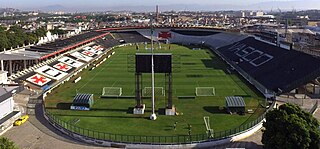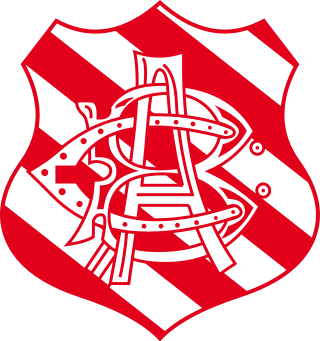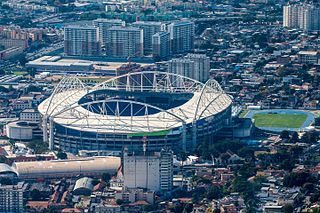
Botafogo de Futebol e Regatas is a Brazilian sports club based in the neighborhood of Botafogo, in the city of Rio de Janeiro. Although it competes in a number of different sports, Botafogo is mostly known for its association football team. It plays in the Campeonato Brasileiro Série A, the top tier of the Brazilian football league system, and in the state of Rio de Janeiro's premier state league. In 2000, Botafogo finished 12th in a vote by subscribers of FIFA Magazine for the FIFA Club of the Century. They have won the Brazilian championship three times, in 1968, 1995 and 2024. Botafogo won the Copa Libertadores for the first time in 2024.

Club de Regatas Vasco da Gama, commonly referred to as Vasco da Gama or simply Vasco, is a sports club based in Rio de Janeiro, Brazil. Although originally a rowing club and then a multi-sport club, Vasco is mostly known for its men's football team, which currently competes in the Campeonato Brasileiro Série A, the top tier of the Brazilian football league system, and in the Campeonato Carioca, the state of Rio de Janeiro's premier state league.

Niterói is a municipality in the state of Rio de Janeiro, in the southeast region of Brazil. It lies across Guanabara Bay, facing the city of Rio de Janeiro and forming part of the Rio de Janeiro Metropolitan Area. It was the capital of Rio de Janeiro, as marked by its golden mural crown, from 1834 to 1894 and again from 1903 to 1975. It has an estimated population of 515,317 inhabitants (2020) and an area of 129.375 km2 (49.952 sq mi), making it the fifth most populous city in the state. It has the highest Human Development Index in the state and the seventh highest among Brazil's municipalities in 2010. Individually, it is the second municipality with the highest average monthly household income per capita in Brazil and appears in 13th place among the municipalities of the country according to social indicators related to education. The city has the nicknames of Cidade Sorriso.

Estádio Vasco da Gama, popularly known as São Januário owing to its location on a street of the same name, is the home ground of CR Vasco da Gama. It is located in the Vasco da Gama neighborhood, in Rio de Janeiro, Brazil, on a hill near the National Observatory of Brazil. Because of its position, it has given Vasco the nickname of Gigante da Colina.

The Campeonato Carioca, officially known as Campeonato Estadual do Rio de Janeiro, also commonly known as the Cariocão, is the state football league of Rio de Janeiro, Brazil. It is under the authority of the FERJ or FFERJ. It is an annual tournament, started in 1906.

Bangu Atlético Clube, commonly known as Bangu, is a Brazilian professional association football club based in Rio de Janeiro, in the western neighbourhood of Bangu. The team plays in Série D, the fourth tier of the Brazilian football league system, as well as in the Campeonato Carioca, the top tier of the Rio de Janeiro state football league.

The Estádio da Gávea, also known as Estádio José Bastos Padilha, is a football stadium, inaugurated on September 4, 1938, in the Lagoa neighborhood, of Rio de Janeiro, Brazil. It has a maximum capacity of 4,000 spectators, and is the home ground of Flamengo, its owner. Flamengo rarely plays at Estádio da Gávea. The club's most used stadium is Maracanã.
Estádio Municipal General Sylvio Raulino de Oliveira, also known as Raulino de Oliveira, and as Estádio da Cidadania, lit. 'Citizenship Stadium', is a football stadium. It was inaugurated on 14 March 1976 in Volta Redonda, Rio de Janeiro State, and has a maximum capacity of 20,255. The stadium is owned by the City Hall of Volta Redonda, and is the home ground of Volta Redonda Futebol Clube. Its formal name honors Raulino de Oliveira, former president of Companhia Siderúrgica Nacional, located in Volta Redonda.

Estádio Luso Brasileiro, formerly known as Ilha do Urubu, Arena Petrobras, Arena Botafogo and Estádio da Ilha do Governador is a football stadium inaugurated on 2 October 1965 in Ilha do Governador neighborhood, Rio de Janeiro. The maximum capacity of the stadium was 6,437 spectators, expanded to 17,250 due to renovations made by Botafogo for the 2016 Brazilian Série A. It was once again expanded to 20,113 by Flamengo in 2017. The stadium is owned by Portuguesa. Nowadays, the stadium has returned to its original capacity after the end of the partnership with Flamengo in the middle of 2018.

Estádio Dr. Adhemar de Barros, usually known as Estádio Fonte Luminosa, or just Fonte Luminosa, is a football (soccer) stadium in Araraquara, Brazil. The stadium has a maximum capacity of 25,000. It was inaugurated in 1951. The stadium is owned by the Araraquara City Hall, and its formal name honors Adhemar Pereira de Barros, who was the governor of São Paulo state from 1938 to 1941, 1947 to 1951, and 1963 to 1966. Associação Ferroviária de Esportes usually plays their home matches at the stadium. Fonte Luminosa means Luminous Fountain.

Estádio Municipal Radialista Mário Helênio, also known as Estádio Mário Helênio, and as Estádio Municipal de Juiz de Fora, is a multi-use stadium in Juiz de Fora, Brazil. It is currently used mostly for football matches. The stadium has a maximum capacity of 31,863 people. It was built in 1988.

Estádio Mourão Vieira Filho, usually known as Estádio da Rua Bariri, is a football stadium in Olaria neighborhood, Rio de Janeiro, Brazil. The stadium has a maximum capacity of 8,300 people. It was built in 1947.

Estádio Olímpico Nilton Santos is a multi-purpose stadium located in the neighbourhood of Engenho de Dentro in Rio de Janeiro, Brazil. It is used mostly for football matches and athletics and is the home stadium of the football club Botafogo. The stadium was built by a consortium under the leadership of Odebrecht S.A., from 2003 through to 2007, opening in time for the 2007 Pan American Games. It hosted the athletics competitions at the 2016 Summer Olympics and the 2016 Summer Paralympics. It was one of the five venues for the 2021 Copa América.

Atlético Rio Negro Clube, usually known simply as Rio Negro is a traditional Brazilian football club from Manaus, Amazonas state.

Caio Vianna Martins (1923–1938) is a famous Scout and a Brazilian national hero.

Resende Futebol Clube, commonly known as Resende, is a Brazilian professional football club in Resende, Rio de Janeiro. The team compete in Campeonato Carioca, the top tier of the Rio de Janeiro state football league.

Estádio Romário de Souza Faria, also known as Marrentão, is a football (soccer) stadium located in Xerém, a district of Duque de Caxias, Brazil. It is named after Brazilian footballer Romário de Souza Faria. The stadium is owned by Duque de Caxias. It replaced Estádio Mestre Telê Santana, nicknamed Maracanãzinho, as Duque de Caxias' home ground.
Estádio General Severiano was a football stadium located in Rio de Janeiro, Brazil. It was the home stadium of Botafogo and it had a maximum capacity of 20,000 people.
The Taça da Prefeitura do Distrito Federal, commonly also Torneio Municipal do Rio de Janeiro, was a tournament for clubs of the then capital of Brazil Rio de Janeiro which was held for the first time in 1938 and which took place annually from 1943 to 1948. The last edition was in 1951. In 1996 the competition was revived for one more time as Taça Cidade Maravilhosa, the "Cup of the Marvellous City", after the byname of Rio de Janeiro. The importance of the tournament is subordinate and it always remained in the shadow of the state championship known as Campeonato Carioca.
The 2016 season saw the return of Botafogo de Futebol e Regatas to the Campeonato Brasileiro Série A, after spending 2015 in Série B.
















